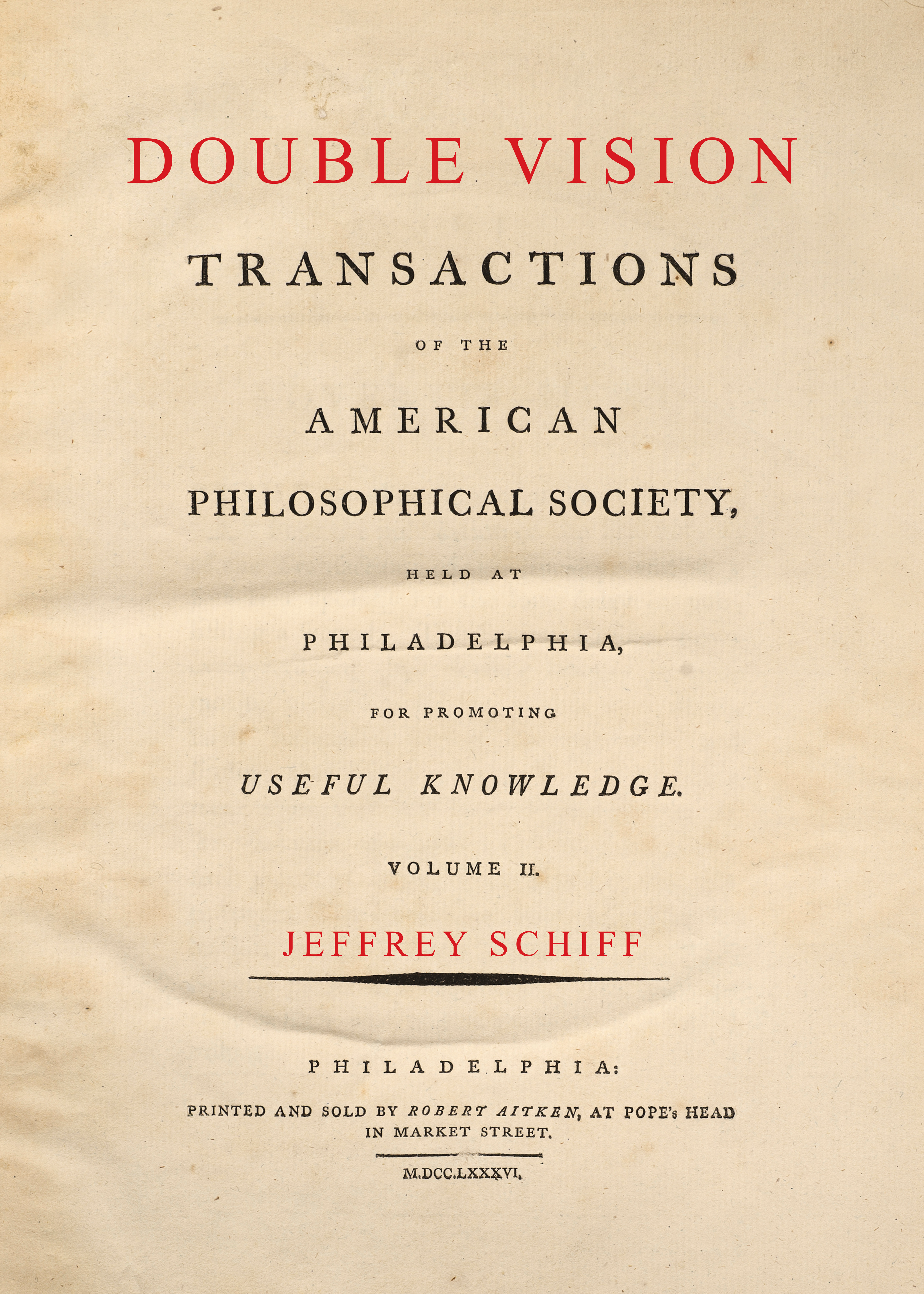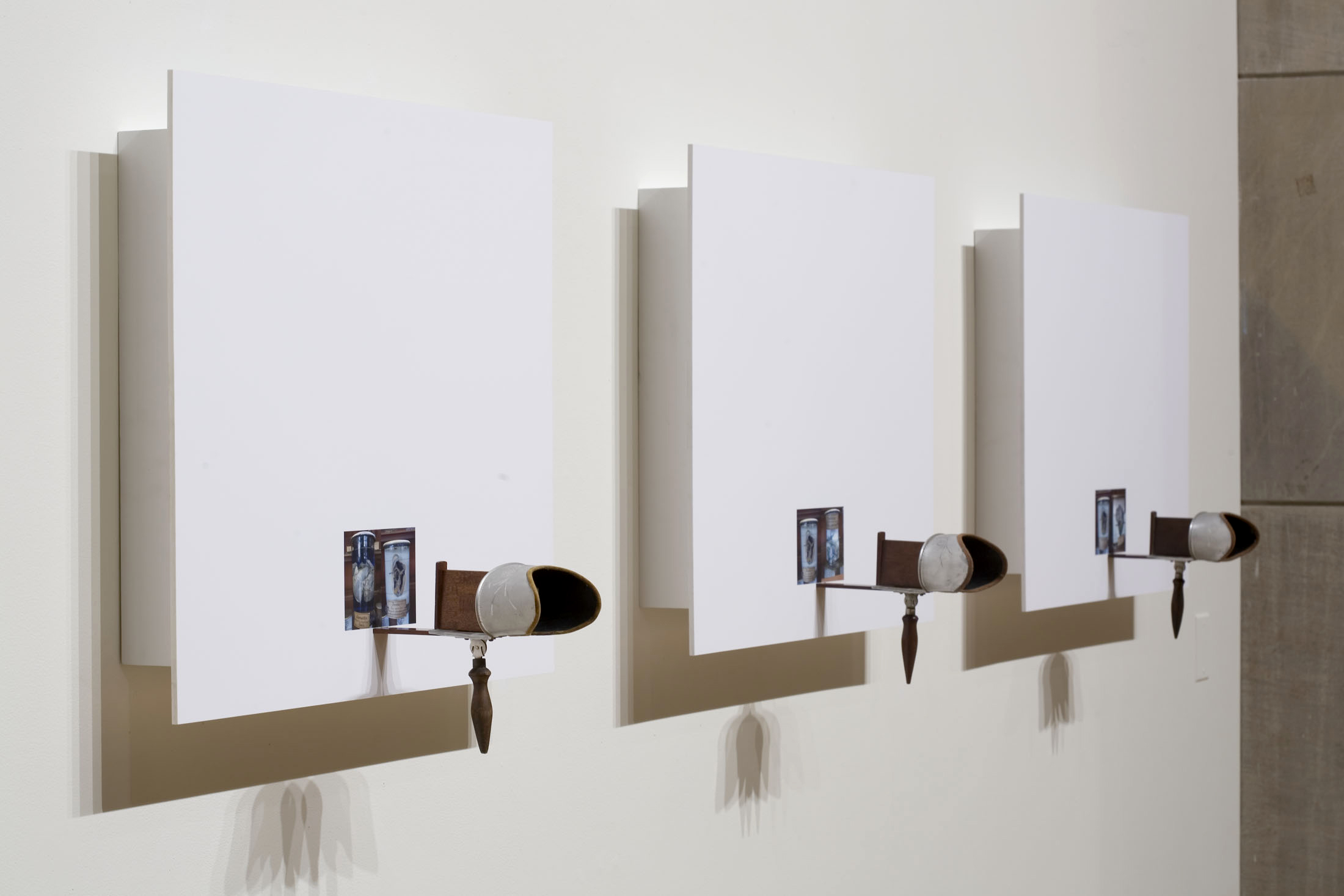Zilkha Gallery, Wesleyan University 2011
Double Vision is a 5-part project that exposes how unconscious projections from America’s colonial origins shape perceptions of its current reality. In 1786, one year before the constitutional convention, members of the American Philosophical Society, which included such luminaries as Benjamin Franklin and Joseph Priestly, published personal accounts of the natural world in the Transactions of the American Philosophical Society. Schiff’s artworks extrapolate from these historical texts to reveal the era’s unresolved struggle between rationality and superstition, democratic ideals and cultural traditions of elitism and slavery–struggles we have inherited as we negotiate conflicting views of scientific enterprise, globalism, religious and ethnic identity and the information age.
Double Vision: Transactions of the American Philosophical Society
Jeffrey Schiff’s Double Vision
by Nancy Princenthal
Seeing double is one route to radical subjectivism: it demonstrates that the world is not mapped point to point in our consciousness. Each eye produces an image, the two are not precisely the same, and neither has priority. Normally they are integrated; intoxication can cause them to separate, as can injury, and various more intentional operations, including the use of optical devices. Vision itself has two meanings, at least, one being transport from the material realm. All these connections have a bearing on Jeffrey Schiff’s enormously ambitious exhibition, “Double Vision.” Inspired by three entries in a 1786 volume of the Transactions of the American Philosophical Society (which appear as photographic enlargements in the exhibition), Schiff has created a series of works that explore vision and its corruption by culturally shaped preconceptions, while also celebrating the spirit of scientific and humanistic inquiry for which the Enlightenment was distinguished, and to which this country’s founding statesmen were dedicated.
Among the most striking features of the Transactions is their seeming innocence, to a contemporary reader. Philosophy, for the Society’s purposes, was generally identified with the natural sciences, about which its members had widely varied knowledge. Formal higher education was scarce among colonial-era Americans: neither Thomas Paine, nor Benjamin Franklin, nor George Washington–all members of the Philosophical Society–attended college. To a twenty-first-century reader, the findings submitted to the Society seem as likely to have been written by Romantic fabulists (or by masters of satire) as by sober scientists; certainly they seem to reflect the idiosyncratic academic strengths of autodidacts.
The account titled “Two Hearts found in one Partridge” begins with the admission that not all of nature’s phenomena are readily understood. The author, one D’Aboville, nonetheless recommends that those which appear “futile should be grasped like the others,” as parts of a chain whose “precious links . . . will be discovered by time.” His own link concerns a partridge that apparently contained two hearts. The interesting viscera were presented to D’Aboville by a surgeon living next door, and both men were eager to show the specimen to a third witness, but the surgeon, stopping first at home, put the saucer containing the entrails on the ground while he fished for his keys, and his dog ate its contents. The subsequent observation of the innards of 48 other partridges confirmed D’Aboville in his belief that he had seen a true anomaly, though his neighbor, noting that no dissection had been made, cautioned, “one cannot be too circumspect in affirming a fact which we ought not to judge of from external circumstances.” Vision, in other words, is not entirely trustworthy.
The second account with which Schiff engages is of “A Worm in a Horse’s Eye,” as observed by F. Hopkinson, Esq. This time, the inexplicable phenomenon is a “serpent” or “worm” seen to be moving freely behind the iris of a tormented horse, which was put on display by its owner, “a free negroe.” The third narrative, by John Morgan, concerns “a motley coloured, or pye Negro Girl,” property of “Mons. Le Vallois, Dentist of the King of France at Guadeloupe.” In relentlessly dehumanizing detail, Morgan describes the mottled coloration of the two-year-old slave’s skin: “The neck, the upper and under part of the chest, the shoulders, the back, loins and buttocks to the junction with the thighs, and the pudendum,” he writes, “are of the colour of her face, but the loins and the thicker part of the buttocks are of a deeper black,” while elsewhere there are extensive white spots, several times further identified as “lively” and “beautiful.” One such white area, on her forehead, is shaped like an “aigrette” (egret), and several like “stars”; other white spots are compared to lunar eclipses. Morgan hesitates to speculate about the causes of the discolorations, but then goes on to note that the child’s mother “delighted in laying out all night in the open air, and contemplating the stars and planets.” He concludes by acknowledging that there are “many who dispute children’s being ever marked by the fears, longings, or impressions made by mothers on the bodies of their children” during pregnancy, while others “are equally confident” of such emotional causes producing physical effects. Taken together, these three Transactions are a portrait of cultural efforts to distinguish subjective impression from objective fact. They split the differences between vision as a faculty that records and one that interprets, or imagines, or perhaps just passionately hopes.
Schiff’s response to the “pye girl” account presides like a colossus over the entryway to the museum at Wesleyan. A child slave named Maria Sabina, whose skin markings were remarkably similar to those of the toddler in Morgan’s account, was the subject of a painting of the period that Schiff has reproduced in rectangular fragments, which are presented within a three-dimensional scaffold reaching eighteen feet high. (Morgan mentions Sabina in passing, referring to a report by Georges-Louis Leclerc, Comte de Buffon, the famous late 18th-century French naturalist.) The topmost painting fragment features an egret on Sabina’s forehead, a bird that in isolation evokes the holy ghost of Christian iconography. (At Wesleyan, the connection is reinforced by the installation of this work in a very tall, narrow, stone-walled gallery topped by a ocular skylight that sheds a particularly ecclesiastical illumination.) Beneath the egret is a single, limpid eye, which mercilessly commands the entering viewer’s attention. Other panels frame telling details of the painting: a parrot on the girl’s finger, also distinguished by a black, piercing eye; a gold earring; a single, ebony foot; a rustic, grass-roofed colonial church, its simple cross lit by a ruddy setting sun. But most of the panels feature segments of the child’s body, and highlight the painting’s peculiar depiction of her dermatological markings, which are rendered as cloud-like, celestial, and at the same time suspiciously evocative of a domestic animal–a dog, a cow.
Superimposed on all the fragments are linear notations–portolani–excerpted from nautical maps of the Mediterranean made by the cartographer Joseph Roux at around the time the Transactions were published. Schiff thereby brings together two sets of measurements for unstable entities: the fluid categories of race, the menacingly changeable seas. The racially equivocal child, a kind of terra incognita, is presented on the movable scaffold as a provisional being, a puzzle not fully assembled.
In the main gallery, mounted on panels attached to a section of wall flanked by the accounts of the anomalous partridge heart and infested horse eye, are five old-fashioned stereoscopic viewers. Each device is trained on a pair of photographs of equally old-fashioned glass-jarred specimens–collected by the same Buffon who observed Sabina–from the Museum of Natural History in Paris. One specimen in each pair is a human heart, the others are hearts from a monkey, a crocodile, a manatee, a tortoise, and, most evocatively, a pygmy hippopotamus. What one sees when looking into the viewer is a muddled hybrid of the mismatched organs: whereas stereopticons are designed to present subjects with preternatural clarity, these deliver images of confounding complexity, which a viewer struggles in vain to bring into alignment. But the photographic pairs can be seen clearly when one steps away from the optical devices, and the hearts’ similarities calculated. A sixth stereopticon is trained on paired videos–they are screened on iPhones, the same devices used to produce the imagery–of the block of Arch Street in Philadelphia where the worm-bedeviled horse was long ago displayed (and not far from the original meeting place of the Philosophical Society). One video delivers a steady, back and forth scan of the street; the other careens wildly, sending the placid thoroughfare with its banal modern architecture into pandemonium. In other words, a normal equine view is paired with the view from the eye of a frantic worm. The stereopticon fuses the two into an impossible collage, the trees and buildings as seen by the worm streaming in swirling floods over the placid city blocks.
Occupying the floor at the center of the exhibition space is an irregular array of roughly three dozen simple terra-cotta pots, all hand thrown and no two exactly alike, although it takes awhile to see that. Full-shouldered and short necked, they have thick-lipped mouths small enough to make it impossible to see inside. Most are intact, but six are broken to reveal stupa-like clay vessels concealed within–as with the dissected partridges, revelation comes at the price of destruction. These interior forms are also each unique, some shaped like spinning tops, others onion-domed, or conical. Shards of the smashed pots litter the floor, which evokes an archeological site. Along with the pottery fragments, wheat grain spills from the broken vessels, completing an image of spiritual and material nourishment in counterpoise, and of the pattern of generation as an enduring mystery.
In the rear gallery is an assortment of sculptures called “Propositions,” all made of glassware designed by Schiff to suggest laboratory vessels, and all placed on battered laboratory tables. Hung vertically on the back wall, one table–its black enameled top suggests an old blackboard–supports two big-bellied beakers, each containing equal amounts of oil and water. One of the beakers is shaken at regular intervals by a motorized mechanism, so the two fluids alternately emulsify and separate. Mounted side by side, the round flasks inescapably evoke eyeballs. Four other tables, placed on the floor, support flasks, retorts and beakers in various confounding configurations. The simplest Propositions pair two beakers, one containing oil and the other water, each pair connected by stunningly long, graceful necks such that eventually the unlike fluids will combine. The most complicated of these sculptures joins two round glass-filled beakers with five oil-filled flasks as delicate and elegant as perfume bottles. The tubes linking them form a dizzying, sinuous maze, which a system of valves turns into a pattern of circulation that suggests both anatomy and alchemy.
All the glass sculptures encourage the admixture of inimical things–the kinds of contamination that resulted, eighteenth-century naturalists speculated, in mottled skin and worm-infested eyes. Like the stereoscopes, they induce combinations not found in nature. At the same time, their grace and clarity reminds us that any well-formed proposition–any elegant conceptual model–is liable to acquire the force of a truth to which observable reality is made to conform, often long past the point when knowledge renders it untenable.
And yet, obsolete models ultimately do give ground, often yielding unintended resources. As it ages, science becomes literature. Aristotle’s writings are taught in departments of classics, Freud’s more often in those of cultural theory than of experimental psychology. They are read as artifacts of culture, not sources of data. No branch of biology relies on unaided human eyesight. Philosophy has distanced itself from both scientific research and artistic evaluation, though whether it primarily concerns moral, spiritual or material things remains an open question. All of these shifts and realignments come into play in Schiff’s “Double Vision,” as they have in his previous works. Earlier projects have concerned Eastern philosophies (he has made extended trips to Japan and India) and Western ones (a recent installation was made in response to Diderot’s Encyclopedia). Sustained themes include the blurry distinctions separating functional and fanciful objects, and normal and anomalous things; the intersection of raw sensory perception and conscious awareness; and the tension between faith and reason. All were of interest among contributors to theTransactions of the American Philosophical Society as well, and represent connections between their era and our own.
“The troubles we continue to have with notions of the ‘natural,’ the ‘aberrant’ and what constitutes evidence and rationality seem to me to be rooted in the intellectual origins unwittingly revealed in the Transactions,” Schiff says. “And the current resurgence of political claims using our founding documents to validate cultural traditions remind of the malleability of such material.” Opening up the Philosophical Society’s record of retrograde assumptions, bold curiosity and lively speculation with the force of his own imagination, Schiff induces several varieties of deeply illuminating double vision.


